#Our base was like fully contaminated with corruption
Explore tagged Tumblr posts
Note
If the characters of Blind Trust could play Terraria, what would their favorite part of the game be and what would be their least favorite?
Love this. Love this question.
Scott would absolutely love Terraria for a lot of the same reasons as I do. Exploring is fun. Treasure hunting is exciting and if he's sharing a world with other people he'd really enjoy gathering resources and potions and mapping out paths for others to do more exciting things. Most combat would be okay, though he'd probably use summons to do most of the fighting for him so he can keep digging tunnels and looking at stuff. Bosses would be incredibly stressful for him.
Edgar and Tenzin are already established to be really into Old School RuneScape, though Tenzin is a way more competent player who pretty much maxxed out her account years ago. Tenzin would be very methodical and strategic. Definitely a completionist. Probably easily frustrated by anyone else they play with.
For some reason I get the sense Edgar would die constantly, be it from traps or fumbling controls during combat. But I think they'd be deeply invested in building. They'd probably argue with Tenzin on whether it's worth placing all the villagers in their "ideal biome". At some point they'd probably hang back while everyone else was mining and wire a ton of weird traps. Scott would be amazed, Tenzin incredibly frustrated.
Katy would do what my wife Riley did a couple of days ago, which made our previous world near-unplayable. She would immediately dig to hell, probably taking a reluctant Scott with her for backup, and somehow kill the Wall of Flesh, sending them into Hard Mode WAY too early and plunging the world into chaos.
#writeblr#Lore time bby#Songbird elegies#Riley felt so bad#Our base was like fully contaminated with corruption#Shit was fucked every night#They came back to mine hellstone for us because we didn't even have that#And they realized quickly that we were in a ROUGH spot#It was so cute they were wracked with guilt#They kept repeating “I can fix this”#I had to insist it wasn't a big deal#I did feel terrible for accidentally killing their camel in Minecraft so I guess this is earned
6 notes
·
View notes
Text
Sometimes all you need is a little trust
[DP x DC fic]
[Love at first… murder? - part 21]
<< Prev | Next >>
Part 1
Ao3
---
They sit there in the dark for a while, in embrace. After a moment, Danny leans back, shifting to lay his head on Jason’s shoulder. The tears on their faces slowly dry as they are ignored.
Neither knows how long they sat there in quietude before Jason breaks the silence.
“Let’s… try this again…” He takes a deep breath before speaking up next. “I told you about the Pit, how it… how when I’m under its effects, I lose control.” He runs a trembling hand through his hair.
Danny doesn’t speak, letting Jason talk.
“It’s just that, whenever I feel the Pit, it’s usually accompanied by anger and rage but… Ever since you killed the Joker, ever since we met, it’s changed.
“Instead of anger, the Pit feels calm. Instead of throwing things and beating people up, I made chocolate fudge.
“And don’t get me wrong, I don’t miss the madness. But something made it change, and I’m not sure if I can trust that change… and I think that something… has to do with you.” He ends, looking at Danny.
“Well…” Danny puts his hand to his chin as he thinks “Ghosts are beings of emotion. It’s part of how we’re formed, it’s part of our language, and it’s part of our being. While your ecto has only ever been projecting rage to you before, I think I can at least theorize the reason behind the change.” He starts.
“I think a large part of why you came back in the first place was revenge, which initially made you a revenant. But that was before you were thrown into what I can only assume is some sort of pit with corrupted ectoplasm, which is what turned you or, well, tried to turn you, from revenant to halfa.
“The ecto stitched your undead body and soul together, brought back your mind, and tried to form a core within you, but the corruption prevented it from doing so. So it was only able to give you the beginnings of a proto-core, which is what made it difficult for me to sense you until we were close enough when we kissed.
“And this is currently keeping you in a constant state of being on the verge of core formation.” Danny takes a breath before continuing to hypothesise.
“You mentioned it was the Joker that killed you, and that the change in emotions happened after he died. To me, it seems like one of the reasons, if not the reason, you crawled out of that grave in the first place was to avenge your death and kill the Joker.
“As ectoplasm is largely emotion-based, the contaminated ectoplasm you gained from that pit probably latched onto this anger and want for revenge and held on to it. The contamination is what likely increases your feelings and what makes them able to overtake your actions, as it were.
“After he died, the major driving force behind you being undead, and behind the rage, was gone. As a revenant you should have gotten peace and gone back to being fully dead, your soul finally able to move on.
“But the ectoplasm within you that was left behind must’ve fused your soul back into your body again, not letting it escape as the revenant rage left you. This, paired with the beginnings of you becoming a halfa, is probably why you stayed.
“With the revenant rage gone, the pit likely can’t hold onto that specific emotional range any longer. So instead, it latches onto any emotion you currently feel in the moment, which again, since he died, is probably more peacefulness and happiness due to being avenged. So now the corruption will amplify those feelings instead.
“The amplified feelings might also lean more towards the happier side because of me being around. Either because I was the one to avenge you, or because your ecto could have recognised me as the same as you and been calmer because of it. Though…” Danny trails off for a bit.
“I have also heard from other ghosts, I sometimes just have that effect on people as crown prince” Danny says, rubbing the back of his neck a little sheepishly.
Jason had been vaguely following along until the last comment stunned him. “You’re a fucking prince?!”
Danny waves him off unconcerned. “That is something I’ll explain later. There is a lot of other context you’ll probably need before I’ll be able to explain any of… that…”
Jason lets out a breath and runs a hand through his hair once again. “Right, yeah, sure. We’ll come back to that.” As he’s trying to make sense of what he’s been told, Jason decides to get into some of the other concerning stuff Danny mentioned before.
“So… your parents… built an artificial Lazarus Pit?” He tries instead.
“Well, I guess? It’s more of a portal. It doesn’t exactly heal or harm anyone going inside, it just brings them into the Ghost Zone.”
“Right… Where’d they even put it that their children could easily access it?”
“Their lab in the basement of the house.”
“Their lab in the basement?!—”
“Yeah… Looking back on it, I guess the house was practically one big OSHA violation, huh…”
“There was more than just the lab basement?”
“Well, yeah, and I guess the dungeon and the Emergency Ops Center that can turn into the Fenton Blimp on top of the house are another big part of it”
Jason gives him an appalled look.
“A lab and a dungeon?! Why do your parents have a dungeon in their house? I thought parents were some kind of scientists, or like … ghost biologists?! ”
“Mhmm” Danny nods in confirmation. “Technically they’re ecto-biologists, but they also just call themselves ghost hunters.”
“And you’re a ghost?”
“Half ghost. And you are too. That’s what halfa stands for”
“Right, yes. We’ll come back to that in a bit. But first, did your parents know about… “
“About me being dead? Nah, they didn’t. Well, they do now, but not back then.”
“Have they ever hurt you?”
Danny turns his gaze to the side uncomfortably as he considers the question.
“Well…”
“Danny—”
“I guess, not really? I mean yeah, they’d chase after me with guns yelling about how they were going to rip me apart molecule by molecule—”
“They what—”
“But dad’s aim is shit and after a while I began getting better at dodging mom’s shots—”
“They shot at you?!” This seems to give Jason some kind of revelation “Don’t tell me that’s why—“
“But they’re really not that bad. They’ve never actually intentionally hurt me while knowing it was me, their son. But, they’re totally fine now!
“Like yeah, before they knew they gave me a tough time sometimes, but to be fair they really didn’t know I wasn’t some evil ghost there to hurt and destroy.
“And at least they weren’t like the GIW, you know?”
“No, Danny. I don’t know. But please tell me you know this wasn’t okay?” Jason throws him a troubled look.
Danny frowns, shifting to sit up straighter. “They didn’t know—”
“Maybe not,” Jason cuts in, “But that doesn’t mean it was right or that it didn’t hurt you anyway. The fact that they didn’t know doesn’t make it any better.”
“They never hurt me seriously enough that I couldn’t recover—” He tries to protest.
“You shouldn’t have gotten hurt by them at all! Not physically, and not emotionally,” Jason states, giving Danny a pointed look. “You shouldn’t have had to recover.”
Danny shifts his gaze towards the ground with a frown, picking at the grass a bit with one of his hands.
“You sound like Jazz,” He responds with a small grumble.
“This Jazz sounds like a wise individual to whom you should probably listen more often.”
“She is” Danny admits with a sigh. “And you’re right, I should…”
A beat, and then “I’m sorry for shooting you”
“It’s fine! It didn’t hurt me and it’s not like I haven’t been shot at before—” Danny tries to reassure, but Jason shakes his head.
“No, Danny. It is not fine. I shouldn’t have done it. And you shouldn’t be used to it.” He says decisively.
“But—”
“Nuh-uh, nope. It is not fine. I should not have done it. Period.”
“You likely had a good reason—”
“I did it because I wasn’t sure I could trust you,” Jason replies.
“I mean, you appeared out of nowhere, basically avenged my death, affected the Pit and made it act in ways it never has before, and then finding out you might have connections to the League?
“I just, it—It scared me” Jason confesses. “And I couldn’t deal with that fear.”
“So, I used my good old Red Hood interrogation techniques to try and get answers. You know? Shoot ‘em in the calf or thigh so it’ll be painful for them without being lethal and make it harder for them to get away.
“But while those are explanations for what I did, none of that is an excuse. There is no excuse.”
“That’s not true.” Danny tries to interject with a shake of the head.
“I’m a terrible person who has done terrible things.” Jason interrupts.
“Not just to you, but others as well. I’m dangerous. I’ve hurt innocent people. I’ve hurt my family. I’ve almost killed some of them— and not all of those times were because of the Pit, either!” Tears have formed in the corners of Jason’s eyes.
“Hey, I’ve killed someone too,” Danny objects, “The Joker counts, and I don’t have a Pit.” He tries.
“Danny, you did it on accident, and if anything the Joker definitely deserv—”
“Well, then I guess I must be a terrible person too” Danny cuts in. “For liking you despite all of that”
“Danny…”
Danny ignores Jason and grabs his hands in his own before looking him back in the eye.
“Maybe you’re not good for me. Maybe I’m not good for you. Perhaps we’re not good for each other, not good together. Terrible together“ Jason opens his mouth to say something but Danny quickly continues, not letting Jason get a word in “But I’d still like to give this a try. To give us a try.”
“Maybe it’ll end in disaster. Maybe it won’t, but… I’d be willing to take that chance… together… If you’d still have me?”
“Danny, I interrogated and shot you. Not just with bullets that didn’t hurt you, but also with a ray gun that you gave me that did hurt you. If anything, I should be asking you if you’d still have me despite all of that.” Jason says, clearly distressed, a few stray tears now rolling over his cheeks.
“And I doubt you’ll pull anything like that again, will you?” Danny asks with an eyebrow raise he learnt from the countless amount of times Jazz threw it at him.
“God no—”
“Then I don’t see the problem.”
“Danny—”
“We can go to couples therapy,” Danny states resolutely.
“Danny—”
“We can each go to normal therapy as well.” He adds on.
“Danny—”
“Jason Todd.” Danny interrupts. Jason stills. “Will you be my boyfriend?”
After a beat of silence, Danny adds on “On the condition we keep up clear communication between the two of us, and perhaps look into getting some form of therapy, of course”
Jason lets out a slightly exasperated huff and wipes the tears away, before giving Danny a soft look.
“You’re too trusting.”
Danny lets out a hum.
“And you don’t trust enough. But I’ve heard opposites attract, so…” Danny pauses. “What do you say?”
Jason gives him a small smile.
“If you’d still have me?”
The response is immediate.
“I do.”
Danny places his hand on Jason’s cheek.
“May I?”
Jason nods.
They both lean in, and they kiss.
---
Jason feels the Pit stir and resolutely ignores it and whatever feeling it brings with, keeping his eyes closed and gently pulling Danny in closer.
You’re not gonna ruin this for me.
---
Taglist:
@i-always-say-yea @uraniumwizard @why-must-i-be-like-this @griffinthing @i23432i @imsotiredfanficlovertm @jaguarthecat @arkita-shadow @noideawhatshappeninghelp @jaitwin5 @apple-juice16 @mossy-bonez @harvestandhearth
#dp x dc#dp x dc fic#dpxdc#dcxdp#dc x dp#dp x dc crossover#dead on main#dead on main ship#it was getting too long#so i split the chapter into two#yes this means next chapter is almost preety much done#will probably be out around the end of next week#also this is fast burn#so yeah might not be 100% realistic#just didnt wanna dwell on angst for too long :p#and for now danny can only guess abt the pit stuff#hes not a doctor#also if you suddenly notice some differences i got feedback that i used a bit too much italics and bold#so i changed it and edited the chap here and on ao3
89 notes
·
View notes
Text
Change Your Mind Review (SPOILERS)
Now I don't usually do reviews, but man, I can't NOT talk about this episode. I'll be pointing out the best, the worst, and the confusing, as well as some speculation. Prepare yourselves, because this will be a long one, and I have no idea how to do the "keep reading" thing on mobile. Really sorry! So I guess we'll start from the beginning. At first, I had no clue Steven was sleeping. It didn't hit me at all until it was revealed that Connie was gone. I thought it was a nice way to start, because the audience was just as disoriented and lost as Steven was in that moment. That, and it was made obvious that this was a regular occurrence for Pink. Then there's Blue herself. She was furious because she couldn't understand his actions, and when Steven tried to get her to understand, she retaliated because she couldn't. In real life, people try to explain things using what they know, even if the information they have isn't accurate or reliable. People assimilate new knowledge into the old, because that's easier than changing the information you have. This is where many prejudices come from. When new and old information conflict, it can create a strong dissonance, and generally, people don't know how to react to that. So if assimilating doesn't work, they reject. Luckily for Steven, he was able to contextualize the situation in a way that Blue could understand. Though it's not totally clear if Blue fully understands (and it wouldn't be realistic to expect her to after eons of being told that organics are inferior and that non-identical fusion is atrocious), she realizes that she had indeed been doing something wrong. This scene gave me hope. If one Diamond could find it in herself to change and move on, then maybe the rest would too, though I had no idea how the crew was going to pull it off in the next 40 minutes. Then there was Yellow. She had all of the same issues that Blue had, and more. The thing with Yellow was, she was already trying to fix things, but not in the way things needed to be fixed. Instead of working to make things better, she worked to make things WORK. The problem is that making do isn't helping at all, but rather maintaining the flawed system that continues to hurt the lower-caste Gems, and the Diamonds are still miserable anyway. Yellow is fully aware of this, yet she still reacted violently when Blue tried to do something different. Why? Fear. Ultimately, this is White's system, and to try to change it would mean incurring her wrath. It's mentioned that White had poofed a Diamond before, and if the old murals were anything to go off of, it was probably Blue. Yellow didn't want that to happen again. Even if it meant hurting Blue now, she wanted to guarantee that White wouldn't do something worse. For someone as structured as Yellow, it only made sense that reaching her meant showing her that "making it work" just wasn't working. I thought it was a touching scene overall. And oh boy, was I excited when Bismuth arrived to fight off White. And then when it was revealed who was flying the other ship, BOOM. Lapis and Peridot, ladies and gentlemen! I absolutely loved the new designs, I gotta say, though that was when I got my first nitpick. Where did the orange in Lapis's sash come from? A homage to Jasper? On a blue Gem??? Gems are usually analogous in their color schemes, so to see a contrasting color on her was odd. Though maybe it's possible to see spots of other color in real lapis lazulis? I wouldn't know, and I could be wrong. It still irked me a bit, but in the grand scheme of things it was easy to overlook. Just feel the need to mention. White's ship's eyes? Those are horrifying. Put them away. Put corks in the pupils. Please, for the love of Sugar, those are going to give me nightmares. But at least seeing her trying and failing to swat everyone was pretty dang funny for someone who seemed so poised and perfect a few episodes ago. We. Finally. Got. More. Steven. Fusions!!! Smoky's outfit was adorable, Rainbow Quartz was a little surprising but definitely acceptable (I love Pearl's jacket by the way), and Sunstone was... uhhh??? Unique? Not what I was expecting from Garnet, that I will say. But the Fourth Wall breaks absolutely killed me. I guess I sort of liked the fusions? They were nice, but I was kind of simultaneously wishing to see more of them, and for their introductions to be spaced out more. It kind of felt rushed together. Also, fusing with a Gem before she's ready to reform seems really dangerous, but I guess it isn't. And what was with the whole "our only hope is for the four of us to fuse" thing? There were literally three other perfectly good gems right there. Obsidian. That was their name, right? They were pretty much exactly what I was expecting, and they are great monster mom. "YOU'RE HUGE!" Cue even huger giant woman robot mecha ship monster. The resulting climb/battle was equal parts awesome and amusing. The Gems crawling into the pupil gave me Big Jethro vibes. Considering who Sugar is with, it was probably intentional. (Wink wonk IJQ?) We totally called it with White Pearl. But to think White would do to the other Diamonds what she did to Pearl? That was really unexpected. That whole scene was unsettling and utterly terrifying. You know what I noticed about White throughout? She was projecting. The fandom generally seems to agree that White is very abusive towards the Diamonds, and her behavior definitely lines up. One thing that people as a whole have in common, I believe, is a desire to be good. Nobody really WANTS to be bad, but we are well aware that some people just are. And we don't want to be like those people. For some that means volunteering, and for others that means being polite to strangers. Most will try to suppress their flaws in some manner, as White pretty much outright admitted to doing. In some cases, though, oftentimes in abusive situations, there is a tendency to project those flaws onto others. White told Steven that he surrounded himself with weaker beings so that he could feel strong, but isn't that what White herself did? It's easier to say something is wrong with someone else than yourself. And then she made them "better." She did something that "helped," so now she could say she did something "good." And bad people don't do good things. By changing the Gems like she did, she was reinforcing her notion that she was doing something good, and therefore she could continue with that behavior. This is likely also why she talked over Steven in "Legs From Here To Homeworld." If he got a say, he could say something to challenge her world view, and that's scary. She couldn't accept that she had done something bad. ...There are theories and fanfictions everywhere discussing what would happen if Steven's gem was removed. Most decided that he would die. Some said Pink/Rose would come back. I guess now we know? He doesn't die, but he was severely weakened, possibly dying. Not that anything else could be expected in a kid's show, at least not on-screen. Not a disappointing outcome, though. What I don't get is, what WAS Pink Steven? Whatever that was wasn't a Gem, or at least not a Gem in the sense that we have come to understand Gems. I think that was just the Gem essence within Steven or something? Hopefully there will be something later on further explaining whatever that was. And can we talk about "SHE'S GOOOOOONNNE!" Uh, what?! It got a little Dragonball there for a second. But... why? Why is Pink Steven so OP? He made White, the strongest of all the Diamonds, fall down. Doesn't sound like much, but when a show makes a point of pointing out "Wow, this character is stronger than all of the other characters," that's a really big deal. But how, and why? Why is Pink Steven OP? Why is Pink Steven OP?! Please explain, Rebecca! :0 So, is Steven a human-Gem fusion then? Because that gave me some serious "Jailbreak" vibes. Oddly enough, it makes sense, and I am totally okay with this. White's Blush really brings out her whites. Cutest thing since Peridot's laugh on the Moon Base. Very precious. I shouldn't say this about evil immortal alien queens, but White is a gumdrop. Huh, White sure had a lot of ideas for what she was supposed to be. She had to get those notions from somewhere, right? That tells me that there has to be something out there greater than the Gems, possibly their creators? Everyone has their place in the Diamond Authority, including the Diamonds themselves. That means White was given her purpose. Perhaps she was in a similar boat to Yellow, maintaining the image to prevent wrath from higher up? Not at all related, but how did she know what a child was, anyway? We. Are the Diamond Authority. We'll try to save the corrupted Gems. And if you think we can't, we'll have a bubble bath and prove you wrong. JASPER. PADPARADSCHA. I love how every shot White is in, she just has this sneer like, "Ew, what am I even doing here, what are these things, is this water contaminated, where did these people come from, can we please just get back on the ship." It's nice to see that the Diamonds are really trying now. It's too late to correct their past wrongs, and they're probably not going to do a complete one-eighty after all the conditioning they've been through, but they're on their way to being their better selves, and I am happy for them and wish them the best. All in all, a wonderful episode all around. If this was why Steven Universe has such a wonky schedule, then keep it up if it means we get more like this.
#steven universe#su#su spoilers#spoilers#long post#longpost#review#change your mind#su change your mind
16 notes
·
View notes
Text
Research: Project Defuture The Future
Randolph Lamonier
Randolpho Lamonier, is a visual artist from Minas Gerais, born in 1988.
He developed several works, specially photography articulated with other languages. He deals with several daily experiences in the city as a form of work, in which photography leads to multiple forms of symbolic exchange.
His work moves between different media, with a leading role in the practice of textile art, drawing, photography, video and installation. In his research, word and image are always together and tend to talk about micro and macro politics, urbanities, sentimental lies, chronicles, diaries and multiple crossings between memory and fiction.
The work done in fabric and embroidery brings sentences like: “ In 2040, we legalized love and other less intense drugs”, and is part of a set of creations in which Lamonier elaborates predictions based on thoughts about the present. “ I always create these works from guidelines that I consider urgent”, explains him.
In the words of the artist himself: “I make flags with what I have. I have never been so foreign. I draw poems, calls for help, war cries, everything is very urgent. The air is contaminated, the floor is covered with debris; sheets, pots, ropes, concrete, broom. Under the rubble the seeds grow in a hurry”.
Perhaps something more interesting than his incredible flags, are the themes he addresses, most of the time making a prediction of the future, about things that could happen in Brazil.
He is indignant with everything rotten that has in Brazil, from the corrupt government, the uncontrollable drug trafficking, the misogynistic society that still exists in Brazil and in several Latin countries, up to the violence itself.
He creates these flags in order to have some kind of hope for Brazil in the future, creating an utopia, where the problems would be thrown away.
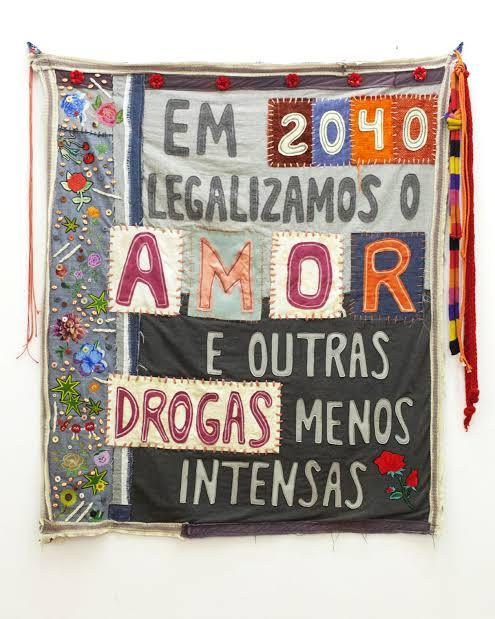

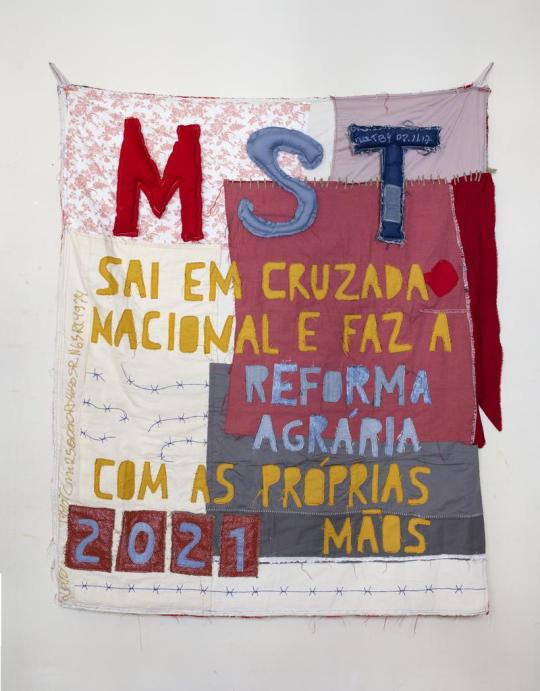

David A Smith
Is a British designer who is specialized in lettering.
He started his own company own sign writing company in 1990 and after 13 years sold the business in 2003 to concentrate more on hand crafting lettering and glass gliding. His main techniques include water and oil gliding, acid etching, French embossing, screen printing and sign writing.
His career in sign writing began in 1984, when he left Westlands school in Torquay, age 16 and was apprenticed for 5 years with Gordon Farr & associates. They were a traditional sign writers, who had come up through the ranks and Gordon, had an uncanny ability to paint letters, accurately laid out, without even a sketch. Under their tutelage, David became an accomplished draftsman, and a accurate letter painter.
This gathering of talented sign artists, carvers and muralists experts. David passion for creating elaborate, ornate mirrors&reverse glass signs of distinction.
In 1992 he set up his own business in England dealing every aspect of sign trade from vehicle graphics to 3D installations.
In 2012, Smith was hired by the singer John Mayer to design the album cover, of ‘Born and Raised’. The cover was styled like 1900 trade card.
He has also worked on posters and other merchandise associated with the album and single.
He was also commissioned by Jameson Whiskey to design a st.Patrick’s Jameson Whiskey bottle for the brand.
David sold the business, to concentrate more fully on gilding, painting e acid-etching glass, adding cutting, so that he could fully replicate the Victorian glass work he admire so much.




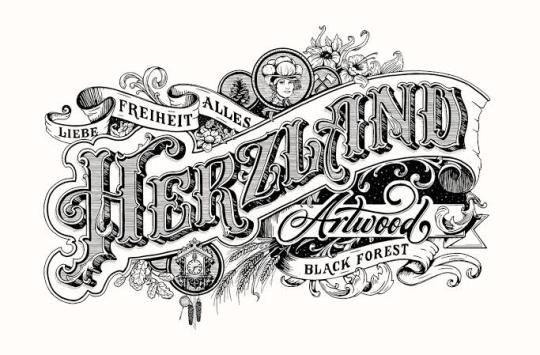
Thomas Burden
Burden is a senior designer at the design boutique “I Love Dust”.
He likes to produce work that references the pieces of vintage tat and printed material he gets from car boot sales and junk shops. Thomas Burden has created work for book covers, ad campaigns, music videos and magazine editorial to packaging, and even animations.
Thomas Burden was always encouraged to be creative, he was allowed to draw murals on the walls of his house, when he was very young. He had many references to do his drawings, in his grandparents house, full of Alpine memorabilia and indigenous art.
Toys weren’t allowed in Burden’s life as a child, so he was always looking at catalogs full of brightly colored things.
So in his works he tries to transmit that nostalgic journey to his childhood memories.
In each work there is a maximization of colors and textures and his great influences are: the film director Wes Anderson and the artist Mark Ryden.
On his own words: “ I was lucky enough to have a pretty idyllic childhood. I grew up sailing and skiing and traveling, so our house was full of souvenirs that parents collected, along with various bits of old boating junk and pieces of old cars”.
As an 3D illustrator / Art director from UK. He had worked with many different clients such as Nickelodeon, The New Yorker, Apple, McDonalds, Penguin, Bloomingdales and Ford.
His signature style is mainly the toys that he was never allowed as child, combined with fairground / neon signage and anything bright and fun that catches everyone’s eyes. He create works in Cinema 4D, also using the Adobe Illustrator, Photoshop and After effects.
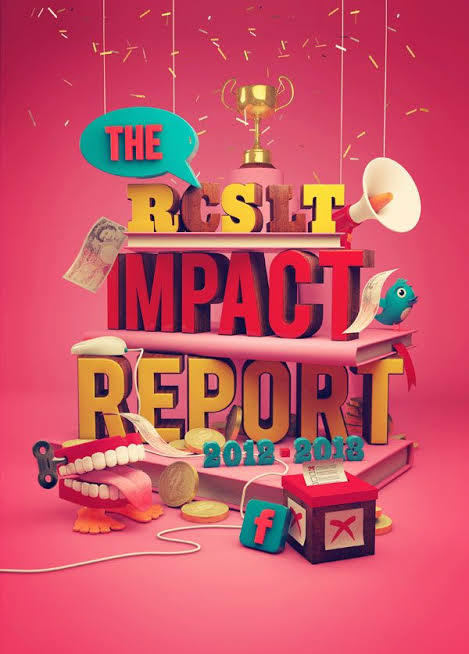




Barbara Kruger
Barbara Kruger is a postmodern artist who was born in 1945 in New Jersey. Having grown up in a middle class family, her first job was as an operator. In 1965 she graduated from The Parson Design School in 1965 and worked as an art director in different magazines. By breaking some barriers of the modern art, Kruger and other women artivists ( art + activism) demonstrated not only against the bonds of patriarchy in society, but also within cultural production. Being an artistic medium an environment built largely by male hegemony, feminist art presents itself as a mean of liberating women. Her works examine stereotypes and the behaviors of consumerism with text layered over mass media images. Rendered with black and white, with a red background, Kruger’s works offer up short phrases such as “Thinking of You” and “I shop therefore I am”. Kruger uses language to broadcast her ideas in a myriad of ways , including through prints, T-shirts, posters, photographs, eletrônico signs and billboards. Despite the work of feminist artists of the twentieth century to change the way women are portrayed in the art world, today this representativeness still confined by a backward ideal. Thus, the work of Barbara Kruger proves to be even more relevant and undoubtedly necessary today.
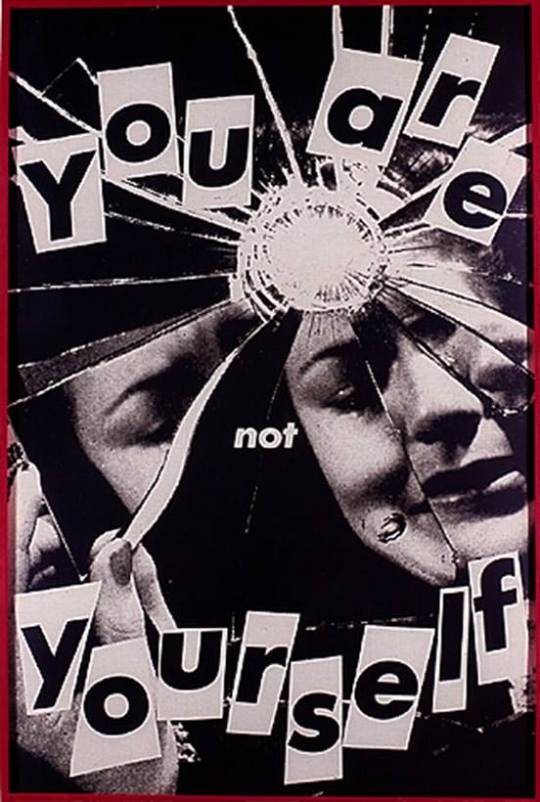




Mike Perry
Mike Perry is an artist that makes paintings, animation, sculptures, books, public art installations, monographs, silkscreens and more. Mike Perry was born in Missouri, United States, and grew up in Kansas City. He started drawing at the age of four. He attended to the College of Art in Minneapolis, and earned a degree in graphic design. Mike Perry's style of using extremely vibrant colors, and making totally stylized designs with a lot of personality is something that draws my attention mainly. His letters are always around a totally imaginative space, which can be both a forest and even a city. The creativity in making those compositions for his posters is something very captivating, not necessarily making a poster that matches with the reality, but doing something perhaps lysergic. His works can be considered love notes to the abstract, unknowable future that is all possible in the present. Illustrator Ana Benaroya said that , “Mike Seems like a modern surrealist to me. His works feels like a childhood memory of slipping down a giant water slide during summer. Slippery and wet and innocent but not innocent. His drawings feel like they just fell right out of his brain onto the paper”. I think he is a great influence, especially for this project. Because I'm wanting to go overboard with the lyrics and the drawings, wanting to do something totally experimental, doing something absurd and creative at the same time. And with this nature theme, I want to make posters with extravagant animals and unconventional scenarios. How he uses photoshop and Procreate for most of his work. I would like to use Photoshop again for this job to continue to learn painting techniques.




Filipe Grimaldi
Filipe Grimaldi is a lyricist and designer. He has been working in the graphic design market since 2006 and, in recent years, has been focusing on the study of manual techniques of calligraphy, lettering and letter painting, migrating part of his work to the development of letterings and commercial decorative painting.
He even give practical classes in ateliers of other institutions. His works can be seen on walls, slates and thousands of plaques that circulate around with his characteristic traits.
Filipe Grimaldi works on the primary chromatic contrast, a key element for the graphic construction of the alphabet.
Letters, words and sentences are organically raised, avoiding the precise math of right angles.
I met Filipe Grimaldi at EBAC in 2019, when he taught a class of typography, teaching how to make a freehand letter. I was impressed, because I saw great perfection and lightness when he drew those letters.
In addition to using several very vibrant colors in his works, even looking like a lettering of an entertainment show.
He even painted on a mural at EBAC, where even I had the opportunity to give a light brushstroke in one of his letters.
For 13 years, Filipe has been specialized in manual techniques of calligraphy, lettering and letter painting. In his own words: “ My authorial research and commercial activities ended up leading me to rescue the calligrapher profession, an almost extinct activity in the development of technology and printing and clipping machines”.
Currently, he teaches typography and calligraphy, for college students, with the goal of encouraging people to try more hand-made letters.

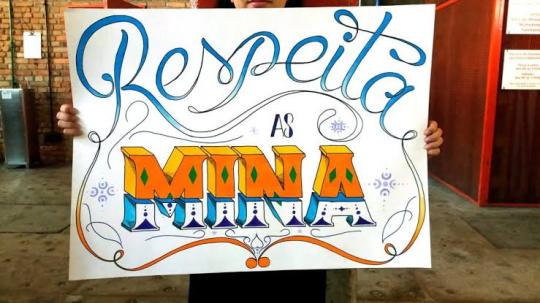



Wayne White
Wayne White is an American artist, typographer, cartoonist and puppeter. A former set and character designer for the television show Pee-Wee’s Playhouse, White produces ironic, often subversive imagery. On Pee Wee’s Playhouse where his work for his set and puppet designs won three Emmys; he also did many voices on the show. He is best known for his word paintings composed of oversized, three dimensional text painted onto cheap landscape paintings he finds at thrift stores and markets. In 2000, he began painting words and phrases, on thrifted lithographs. “When you think about it, you’re surrounded by giant letters and words everywhere”. White said once. “We don’t take for it granted, but the whole American landscape is nothing but a giant letter forms”. One Journalist said his opinion about White’s paintings: “the weirdest landscape painter in America, White uses master painting techniques to create the illusion of words and phrases surreally disappearing into the horizon or jutting out from each lithograph’s place setting.” White’s famous “word art” paintings hang in museums and galleries across America. His paintings features technically proficient and wildly colored phrases that are funny and sarcastic. And critics have praise White’s series for being entryway to the artist mind. Over the past years, White has worked primarily as a fine artist with solo exhibitions of his paintings and sculptures in galleries in New York and Los Angeles. In 2006, he created a giant head sculpture, with a giant lettering next to head. This marks one of White’s other passions, which is sculpting, and he like to exaggerate on the expression, of the characters that he is sculpting.




Joshua Noom
Joshua Noom is a famous illustrator who was born in Australia, in 1988. He is very popular in the social networks, specially in Instagram, where his minimalist illustrations and typography have earned him over 60,000 followers. He had created several illustrations for musicians and major brands like, Miller High Life, Sony, and Warner. Today Noom lives at Florida, and he is specialized in detailed and bold illustrations combined with an organic sense of typography. One of his most recent works, was recreating the Bible’s cover, with many other Christian artists. Each artist offers a visual entry point focused on a particular biblical theme or passage, setting a tone of reflection as readers engage with the Bible. I’ve been looking at Joshua works, and I really like the feeling of gritty and inky that he puts in his illustrations. Some of his works feels military inspired and masculine, while other pieces feel soft and feminine, like some vintage postcards that he produces. Something that Josh uses in most of his work, and that connects with my posters, is the use of wild animals and different situations. It can either make a tiger surfing, or even protest posters for the preservation of wildlife. He has a very intense passion for animals, and he enjoys drawing them in very expressive ways. With strong colors, with its minimalist style, and texts with different fonts around it. In a interview Josh even discusses his style “ My inspirations for my style are mostly from music and other art, but one artist that I’ve been diggin’ is Mark Conlan. My style has just kind of developed over the time and I think I will probably keep evolving. After many attempts of trying new things and figuring out what works for me, and what doesn’t for me. I prefer to draw in a more minimalist style, specially using my ink pens. Animals are one of my inspirations, specially here in Florida, we got many different species of birds and reptiles, so like to sit somewhere, and draw any animal that appears, and try to create a composition with different typefaces, to make future posters.





1 note
·
View note
Text
Waterless Mobile Car Wash Services Portland
Mobile hand car wash and valeting service. Details of services, prices, booking, testimonials and area covered. Head on over to mobigleam.com for waterless mobile car wash services in Portland.

Do not use a sponge. Do not use anything that is abrasive like steel wool, sink, or dish scrubbers. They must be soft. They must be fluffy. A wash mitt is the best. It will trap dirt instead of scraping it along your cars finish. A sponge could scratch your car. For tall cars, vans, and trucks, you can use a pole mitt. Make sure you buy a pole with a head that is specifically designed to wash a car. Many will scratch your cars finish. Remember, the fluffier the better. A wash mitt designed for car washing will hold the most suds as well. Suds is what will clean your car.
Waterless mobile car wash;
You may get the contents at any automotive store but by combining all into a car-themed putting gift basket such basic tools for an emergency road kit (road flare, cones, cords, flashlights, reflective vests and fuses) would be well appreciated by the receiver.
Using a pressure wash once in a while removes the dirt from the parts that are difficult to reach. Holding out the pressure wash jet closely to the painted surface might peel the loose paint. Places like behind moldings, inside wheel arches, under the bumpers should be washed off. This is where the dirt and salt could be accumulated. The dirt in the wind shield must also be wiped and washed. Dirts accumulated in the windshield gets caught by the windshield wipers blades and scratches the windshield when the wipers are operating.

What is waterless mobile car wash? Ions are simply impurities that exist in any normal water supply and come in the form of dissolved minerals such as calcium and sodium, When the water evaporates the minerals that were once dissolved in the water are left behind to leave unsightly spots on your paintwork. The normal course of action is to dry your car with a soft cloth or paper towel so that the water doesn't have time to evaporate and leave behind the spots. This is sometimes impractical though, especially on a hot day when the sun will dry parts of your car before you get a chance to get to them.
We also had the waterless mobile car wash services chance to pit the RAZR i against the Droid RAZR M. Aside from the benchmark results outlined above, the Medfield entry offered a marginally faster response to most actions. Powering up both phones, the RAZR i landed at its home screen around 12 seconds ahead of the Snapdragon sibling. Loading into the Chrome browser was around the same speed on both, likewise the camera app - both launching and capture - was equally swift on both. It's interesting to note that the color balance appeared more natural on the screen of the Verizon version, which matches up with our results in the camera test.

Even though there are several lenders who offer car wash loans, you may have a hard time searching for one. Thus, when you are searching for them, you should know where to look as you may not find them listed in the yellow pages of a phone book. The best source to search for car wash loans lenders is the internet. In the space provided in the search engine, you just have to type the required words and within seconds you will be provided with a list of all the lending institutions that offer such funds.
Having enough pressure in your machine will allow you to clean at a deeper level and make fewer passes over a surface to get it clean. Too much pressure will take off the top layer of a surface or damage it beyond repair. When using PSI as the tool of cleaning, always approach a surface from a distance, then moving in slowly for more pressure, until you find the right distance for cleaning ability without harming the surface.
If you've ever bought parts for your car, you've probably got confused at times finding different auto parts outlets offering the same item at a wide range of prices. So you are left wondering whether quality has anything to do with this. In a broad sense, the answer is yes. The higher the price, the higher the quality. However, this is not always the case.
The main area and aim of car detailing is to fully enhance and restore the vehicles paintwork by eliminating light scratches and swirl marks that have been inflicted over time and that reflect the light in such a way that they give an unsightly cob webbing effect on the surface of the paint or clear coat. Before this is undertaken though, the exterior has to be thoroughly washed and cleaned in order to remove as much dirt and as many contaminants as possible. Valeting is something you can get from even a local fuel station - car detailing is more something which is more specialist and a service to hire by looking online. Some firms do have a specialist work facility however.
Babysitters job is not that easy as it may seem to you. A nanny is responsible for a child's meal, entertaining the child, engaging the child in learning activities and to follow the regular bedtime family routine. You cannot be lenient when you are around kids; you have to be always on your toes and keep them in your sight all the time. Kids are very stubborn and you have to be able to convince them to take their meals on time and go to bed on time.
Distressed debt and mezzanine investors packed into a cramped London courtroom to be told that IMO's senior lenders could take ownership of the company, despite objections of lower-ranked mezzanine lenders owed about 90 million pounds ($148.5 million).
One of the first things that you should look for should always be its track record. Do people (who have experienced their service) return? Are they satisfied with the service that they offer? As I mentioned earlier, you can never know what repairs were done to your car, unless you stay in the shop the whole day. The only way to find out how good the repairs were is to drive your car out.
Before you harp on me about the Cadillac Escalade EXT , I have to remind you that the Escalade EXT is based on the much-more-clever Chevy Avalanche, with a mid-gate that allowed the bed to be accessed from within the vehicle, among other goodies. They may look the same, but they don't work the same. Also, being featured in the Matrix movie sure didn't hurt the Escalade EXT's sales either.

The major motive of making use of vehicle protection cover is without any doubt to protect a vehicle against a number of harms which occur driving on the road. Even essentially the most seasoned and also watchful car owners are not guarded against insignificant accidents, therefore providing your own automobile an extra security is certainly a prudent choice.
Pay attention to the signs a potential mechanic gives to you. If he cannot give you eye contact, rushes his words, or avoids answering any questions you have for him, he may be trying to hide something. Perhaps he does not really know what he is doing or is lying about something else. If this is the case, go with another mechanic.
You should not choose a repair shop or a mechanic right away if you are rushed. If your car needs some repairs right away, find a friend or family member who can lend you their vehicle or give you rides until you find a reliable garage or dealership to repair your vehicle.
I'll admit that Lincoln Aviator, the up-scale cousin of Ford Explorer, would make sense. However, whose idea is to up-scale the F-150 Crewcab? Yet it was done, and that became the Lincoln Blackwood , which died after a few years. In fact, there was a Neiman Marcus Edition of Lincoln Blackwood! It then got resurrected as the Lincoln Mark LT after a few years, then died again, at least in the US. The Lincoln Mark LT is still available in Mexico.
Buy a pair of rabbit ears. This is a flexiable rubber seal connected to a metal clamp. This unit is help flush the engine. connect the unit on the lower part of the motor were the water is picked up. Connect a water hose to the back of the rabbit ears.
In recent years, however, the environment has started to shift. In part, that's due to investigative reporting, the prevalence of social media, whistle-blowers, and stronger judicial institutions, according to The Inter-American Dialogue's report. Over the past two decades, more nations have signed on to international corruption and transparency standards like the UN Convention Against Corruption or the Open Government Partnership, of which 14 Latin American countries are signatories and have submitted action plans. There has also been greater investment in judicial systems and national oversight laws.
Understand how the repair shop you are considering charges before signing any agreements. Some shops will charge a flat fee for labor, while others base it off of time. Some will opt for original parts, while others will use generics. Know what you have ahead of you before being accountable.
We just purchased a used car and the entire car was covered in an unknown substance leaving the paint with a rough texture so i needed a waterless mobile car wash. Dealership detailed it and couldn't get it off. Searched on Yelp for a mobile auto wash business and Jay's had 5 stars and great reviews. Called them up and they were able to come out the next day. They communicated with me on their exact arrival time and let me know they were on their way. When they got here three guys got right to work and said they can get the rough texture off the car no problem. Well they didn't disappoint. Whatever was on the car is completely gone and looks fantastic. Price was reasonable and the final product was outstanding. I highly recommend these guys.
youtube
7 notes
·
View notes
Text
Better fact-checking for fake news
The 21st century has opened up a boundless mass of headlines, articles, and stories. This information influx, however, is partially contaminated: Alongside factual, truthful content is fallacious, deliberately manipulated material from dubious sources. According to research by the European Research Council, one in four Americans visited at least one fake news article during the 2016 presidential campaign.
This problem has recently been exacerbated by something called “automatic text generators.” Advanced artificial intelligence software, like OpenAI's GPT-2 language model, is now being used for things like auto-completion, writing assistance, summarization, and more, and it can also be used to produce large amounts of false information — fast.
To mitigate this risk, researchers have recently developed automatic detectors that can identify this machine-generated text.
However, a team from MIT’s Computer Science and Artificial Intelligence Laboratory (CSAIL) found that this approach was incomplete.
To prove this, the researchers developed attacks that they showed could fool state-of-the-art fake-news detectors. Since the detector thinks that the human-written text is real, the attacker cleverly (and automatically) impersonates such text. In addition, because the detector thinks the machine-generated text is fake, it might be forced to also falsely condemn totally legitimate uses of automatic text generation.
But how can the attackers automatically produce “fake human-written text”? If it’s human-written, how can it be automatically produced?
The team came up with the following strategy: Instead of generating the text from scratch, they used the abundance of existing human-written text, but automatically corrupted it to alter its meaning. To maintain coherence, they used a GPT-2 language model when performing the edits, demonstrating that its potential malicious uses are not limited to generating text.
“There’s a growing concern about machine-generated fake text, and for a good reason,” says CSAIL PhD student Tal Schuster, lead author on a new paper on their findings. “I had an inkling that something was lacking in the current approaches to identifying fake information by detecting auto-generated text — is auto-generated text always fake? Is human-generated text always real?”
In one experiment, the team simulated attackers that use auto-completion writing assistance tools similar to legitimate sources. The legitimate source verifies that the auto-completed sentences are correct, whereas the attackers verify that they’re incorrect.
For example, the team used an article about NASA scientists describing the collection of new data on coronal mass ejections. They prompted a generator to produce information on how this data is useful. The AI gave an informative and fully correct explanation, describing how the data will help scientists to study the Earth’s magnetic fields. Nevertheless, it was identified as “fake news.” The fake news detector could not differentiate fake from real text if they were both machine-generated.
“We need to have the mindset that the most intrinsic ‘fake news’ characteristic is factual falseness, not whether or not the text was generated by machines,” says Schuster. “Text generators don’t have a specific agenda — it’s up to the user to decide how to use this technology.”
The team notes that, since the quality of text generators is likely to keep improving, the legitimate use of such tools will most likely increase — another reason why we shouldn’t “discriminate” against auto-generated text.
“This finding of ours calls into question the credibility of current classifiers in being used to help detect misinformation in other news sources,” says MIT Professor Regina Barzilay.
Schuster and Barzilay wrote the paper alongside Roei Schuster from Cornell Tech and Tel Aviv University, as well as CSAIL PhD student Darsh Shah.
Bias in AI is nothing new — our stereotypes, prejudices, and partialities are known to affect the information that our algorithms hinge on. A sample bias could ruin a self-driving car if there’s not enough nighttime data, and a prejudice bias could unconsciously reflect personal stereotypes. If these predictive models learn based on the data they’re given, they’ll undoubtedly fail to understand what’s true or false.
With that in mind, in a second paper, the same team from MIT CSAIL used the world’s largest fact-checking dataset, Fact Extraction and VERification (FEVER), to develop systems to detect false statements.
FEVER has been used by machine learning researchers as a repository of true and false statements, matched with evidence from Wikipedia articles. However, the team’s analysis showed staggering bias in the dataset — bias that could cause errors in models it was trained on it.
“Many of the statements created by human annotators contain giveaway phrases,” says Schuster. “For example, phrases like ‘did not’ and ‘yet to’ appear mostly in false statements.”
One bad outcome is that models trained on FEVER viewed negated sentences as more likely to be false, regardless of whether they were actually true.
“Adam Lambert does not publicly hide his homosexuality,” for instance, would likely be declared false by fact-checking AI, even though the statement is true, and can be inferred from the data the AI is given. The problem is that the model focuses on the language of the claim, and doesn’t take external evidence into account.
Another problem of classifying a claim without considering any evidence is that the exact same statement could be true today, but be considered false in the future. For example, until 2019 it was true to say that actress Olivia Colman had never won an Oscar. Today, this statement could be easily refuted by checking her IMDB profile.
With that in mind, the team created a dataset that corrects some of this through de-biasing FEVER. Surprisingly, they found that the models performed poorly on their unbiased evaluation sets, with results dropping from 86 percent to 58 percent.
“Unfortunately, the models seem to overly rely on the bias that they were exposed to, instead of validating the statements in the context of given evidence,” says Schuster.
Armed with the debiased dataset, the team developed a new algorithm that outperforms previous ones across all metrics.
“The algorithm down-weights the importance of cases with phrases that were specifically common with a corresponding class, and up-weights cases with phrases that are rare for that class,” says Shah. “For example, true claims with the phrase ‘did not’ would be upweighted, so that in the newly weighted dataset, that phrase would no longer be correlated with the ‘false’ class.”
The team hopes that, in the future, combining fact-checking into existing defenses will make models more robust against attacks. They aim to further improve existing models by developing new algorithms and constructing datasets that cover more types of misinformation.
“It's exciting to see research on detection of synthetic media, which will be an increasingly key building block of ensuring online security going forward as AI matures,” says Miles Brundage, a research scientist at OpenAI who was not involved in the project. “This research opens up AI's potential role in helping to address the problem of digital information, by teasing apart the roles of factual accuracy and provenance in detection.”
A paper on the team’s contribution to fact-checking, based on debiasing, will be presented at the Conference on Empirical Methods in Natural Language Processing in Hong Kong in October. Schuster wrote the paper alongside Shah, Barzilay, Serene Yeo from DSO National Laboratories, MIT undergraduate Daniel Filizzola, and MIT postdoc Enrico Santus.
This research is supported by Facebook AI Research, who granted the team the Online Safety Benchmark Award.
from Technology News And Updates http://news.mit.edu/2019/better-fact-checking-fake-news-1017
0 notes
Link
[...] And, finally, even without imputing objective intentions to the art-work, there remains the inescapable truth about perception: the positivity of all experience at every moment of it. As John Cage has insisted, "there is no such thing as silence. Something is always happening that makes a sound." (Cage has described how, even in a soundless chamber, he still heard at least two things: his heartbeat and the coursing of the blood in his head). Similarly, there is no such thing as empty space. As long as a human eye is looking there is always something to see. To look at something that's "empty" is still to be looking, still to be seeing something — if only the ghosts of one's own expectations. In order to perceive fullness, one must retain an acute sense of the emptiness which marks it off; conversely, in order to perceive emptiness, one must apprehend other zones of the world as full. (In Through the Looking Glass, Alice comes upon a shop "that seemed to be full of all manner of curious things — but the oddest part of it all was that whenever she looked hard at any shelf, to make out exactly what it had on it, that particular shelf was always quite empty, though the others round it were crowded full as they could hold.")
"Silence" never ceases to imply its opposite and to demand on its presence. Just as there can't be "up" without "down" or "left" without "right," so one must acknowledge a surrounding environment of sound or language in order to recognize silence. Not only does silence exist in a world full of speech and other sounds, but any given silence takes its identity as a stretch of time being perforated by sound. (Thus, much of the beauty of Harpo Marx's muteness derives from his being surrounded by manic talkers.)
A genuine emptiness, a pure silence, are not feasible — either conceptually or in fact. If only because the art-work exists in a world furnished with many other things, the artist who creates silence or emptiness must produce something dialectical: a full void, an enriching emptiness, a resonating or eloquent silence. Silence remains, inescapably, a form of speech (in many instances, of complaint or indictment) and an element in a dialogue.
[...]
Language seems a privileged metaphor for expressing the mediated character of art-making and the art-work. On the one hand, speech is both an immaterial medium (compared with, say, images) and a human activity with an apparently essential stake in the project of transcendence, of moving beyond the singular and contingent (all words being abstractions, only roughly based on or making reference to concrete particulars). But, on the other hand, language is the most impure, the most contaminated, the most exhausted of all the materials out of which art is made.
This dual character of language — its, abstractness, and its "fallenness" in history — can serve as a microcosm of the unhappy character of the arts today. Art is so far along the labyrinthine pathways of the project of transcendence that it's hard to conceive of it turning back, short of the most drastic and punitive "cultural revolution." Yet at the same time, art is foundering in the debilitating tide of what once seemed the crowning achievement of European thought: secular historical consciousness. In little more than two centuries, the consciousness of history has transformed itself from a liberation, an opening of doors, blessed enlightenment, into an almost insupportable burden of self-consciousness. It's impossible for the artist to write a word (or render an image or make a gesture) that doesn't remind him of something. Up to a point, the community and historicity of the artist's means are implicit in the very fact of intersubjectivity: each person is a being-in-a-world. But this normal state of affairs is felt today (particularly in the arts using language) as an extraordinary, wearying problem.
As Nietzsche said: "Our pre-eminence: we live in the age of comparison, we can verify as has never been verified before." Therefore, "we enjoy differently, we suffer differently: our instinctive activity is to compare an unheard number of things."
Language is experienced not merely as something shared but something corrupted, weighed down by historical accumulation. Thus, for each conscious artist, the creation of a work means dealing with two potentially antagonistic domains of meaning and their relationships. One is his own meaning (or lack of it); the other is the set of second-order meanings which both extend his own language and also encumber, compromise, and adulterate it. The artist ends by choosing between two inherently limiting alternatives. He is forced to take a position that's either servile or insolent: either he flatters or appeases his audience, giving them what they already know, or he commits an aggression against his audience, giving them what they don't want.
Modern art thus transmits in full the alienation produced by historical consciousness. Whatever the artist does is in (usually conscious) alignment with something else already done, producing a compulsion to be continually rechecking his situation. His own stance with those of his predecessors and contemporaries. Compensating for this ignominious enslavement to history, the artist exalts himself with the dream of a wholly ahistorical, and therefore unalienated, art.
[...]
"No one can have an idea once he starts really listening." - Cage
[...]
Another use of speech, if anything more common than that of provoking actions: speech provokes further speech. But speech can silence, too. This indeed is how it must be; without the polarity of silence, the whole system of language would fail. And beyond its generic function as the dialectical opposite of speech, silence — like speech — has its more specific, less inevitable uses, too.
One use for silence: certifying the absence or renunciation of thought. This use of silence is often employed as a magical or mimetic procedure in repressive social relationships. as in the regulations about speaking to superiors in the Jesuit order and in the disciplining of children. (It should not be confused with the practice of certain monastic disciplines, such as the Trappist order, in which silence is both an ascetic act and a bearing witness to the condition of being perfectly "full.")
Another, apparently opposed, use for silence: certifying the completion of thought. (Karl Jaspers: "He who has the final answers can no longer speak to the other, as he breaks off genuine communication for the sake of what he believes in.")
Still another use for silence: providing time for the continuing or exploring of thought. Notably, speech closes off thought. (Cf., the enterprise of criticism, in which there seems no way for a critic not to assert that a given artist is this, he's that, etc.) But if one decides an issue isn't closed, it's not. This is presumably the rationale behind the voluntary experiments in silence that some contemporary spiritual athletes, lIke Buckminister Fuller, have undertaken, and the element of wisdom in the otherwise mainly authoritarian, philistine silence of the orthodox Freudian psychoanalyst. Silence keeps things "open."
Still another use for silence: furnishing or aiding speech to attain its maximum integrity or seriousness. Everyone has experienced how, when punctuated by long silences, words weigh more; they become almost palpable. Or how, when one talks less, one starts feeling more fully one's physical presence in a given space. Silence undermines "bad speech," by which I mean dissociated speech — speech dissociated from the body (and, therefore, from feeling), speech not organically informed by the sensuous presence and concrete particularity of the speaker and of the individual occasion for using language. Unmoored from the body, speech deteriorates. It becomes false, inane, ignoble, weightless. Silence can inhibit or counteract this tendency, providing a kind of ballast, monitoring and even correcting language when it becomes inauthentic.
[...]
in an overpopulated world being connected by global electronic communication and jet travel at a pace too rapid and violent for an organically sound person to assimilate without shock, people are also suffering from a revulsion at any further proliferation of speech and images. Such different factors as the unlimited "technological reproduction" and near-universal diffusion of both printed language and speech as well as images (from "news" to "art objects"), and the degenerations of public language within the realms of politics and advertising and entertainment, have produced, especially among the better educated inhabitants of what sociologists call "modern mass society," a devaluation of language. (I should argue, contrary to McLuhan, that a devaluation of the power and credibility of images has taken place that's no less profound than. and essentially similar to, that afflicting language.) And, as the prestige of language falls, that of silence rises.
[...]
If anything, the volume of discontent has been turned up since the arts inherited the problem of language from religious discourse. It's not just that words, ultimately, won't do for the highest aims of consciousness; or even that they get in the way. Art expresses a double discontent. We lack words, and we have too many of them. It reflects a double complaint. Words are crude, and they're also too busy — inviting a hyperactivity of consciousness which is not only dysfunctional, in terms of human capacities of feeling and acting, but which actively deadens the mind and blunts the senses.
Language is demoted to the status of an event. Something takes place in time, a voice speaking which points to the "before" and to what comes "after" an utterance: silence. Silence, then, is both the precondition of speech, and the result or aim of properly directed speech. On this model, the artist's activity is the creating or establishing of silence; the efficacious art work leaves silence in its wake. Silence, administered by the artist, is part of a program of perceptual and cultural therapy, often on the model of shock therapy rather than persuasion. Even if the artist's medium is words, he can share in this task: language can be employed to check language, to express muteness. Mallarmé thought it was precisely the job of poetry. using words, to clean up our word-clogged reality — by creating silences around things. Art must mount a full-scale attack on language itself, by means of language and its surrogates, on behalf of the standard of silence.
[...]
This tenacious concept of art as "expression" is what gives rise to one common, but dubious, version of the notion of silence, which invokes the idea of "the ineffable." The theory supposes that the province of art is "the beautiful," which implies effects of unspeakableness, indescribability, ineffability. Indeed, the search to express the inexpressible is taken as the very criterion of art; and sometimes, for instance, in several essays of Valery, becomes the occasion for a strict — and to my mind untenable — distinction between prose literature and poetry. It is from this basis that Valery advanced his famous argument (repeated in a quite different context by Sartre) that the novel is not, strictly speaking, an art form at all. His reason is that since the aim of prose is to communicate, the use of language in prose is perfectly straightforward. Poetry, being an art, should have quite different aims: to express an experience which is essentially ineffable; using language to express muteness. In contrast to prose writers, poets are engaged in subverting their own instrument: and seeking to pass beyond it.
0 notes
Video
youtube
Prophets and Kings, pp. 669-678: Chapter (57) Reformation
This chapter is based on Nehemiah 13.
Solemnly and publicly the people of Judah had pledged themselves to obey the law of God. But when the influence of Ezra and Nehemiah was for a time withdrawn, there were many who departed from the Lord. Nehemiah had returned to Persia. During his absence from Jerusalem, evils crept in that threatened to pervert the nation. Idolaters not only gained a foothold in the city, but contaminated by their presence the very precincts of the temple. Through intermarriage, a friendship had been brought about between Eliashib the high priest and Tobiah the Ammonite, Israel's bitter enemy. As a result of this unhallowed alliance, Eliashib had permitted Tobiah to occupy an apartment connected with the temple, which heretofore had been used as a storeroom for tithes and offerings of the people.
Because of the cruelty and treachery of the Ammonites and Moabites toward Israel, God had declared through Moses that they should be forever shut out from the congregation of His people. See Deuteronomy 23:3-6. In defiance of this word, the high priest had cast out the offerings stored in the chamber of God's house, to make a place for this representative of a proscribed race. Greater contempt for God could not have been shown than to confer such a favor on this enemy of God and His truth.
On returning from Persia, Nehemiah learned of the bold profanation and took prompt measures to expel the intruder. “It grieved me sore,” he declares; “therefore I cast forth all the household stuff of Tobiah out of the chamber. Then I commanded, and they cleansed the chambers: and thither brought I again the vessels of the house of God, with the meat offering and the frankincense.”
Not only had the temple been profaned, but the offerings had been misapplied. This had tended to discourage the liberalities of the people. They had lost their zeal and fervor, and were reluctant to pay their tithes. The treasuries of the Lord's house were poorly supplied; many of the singers and others employed in the temple service, not receiving sufficient support, had left the work of God to labor elsewhere.
Nehemiah set to work to correct these abuses. He gathered together those who had left the service of the Lord's house, “and set them in their place.” This inspired the people with confidence, and all Judah brought “the tithe of the corn and the new wine and the oil.” Men who “were counted faithful” were made “treasurers over the treasuries,” “and their office was to distribute unto their brethren.”
Another result of intercourse with idolaters was a disregard of the Sabbath, the sign distinguishing the Israelites from all other nations as worshipers of the true God. Nehemiah found that heathen merchants and traders from the surrounding country, coming to Jerusalem, had induced many among the Israelites to engage in traffic on the Sabbath. There were some who could not be persuaded to sacrifice principle, but others transgressed and joined with the heathen in their efforts to overcome the scruples of the more conscientious. Many dared openly to violate the Sabbath. “In those days,” Nehemiah writes, “saw I in Judah some treading wine presses on the Sabbath, and bringing in sheaves, and lading asses; as also wine, grapes, and figs, and all manner of burdens, which they brought into Jerusalem on the Sabbath day.... There dwelt men of Tyre also therein, which brought fish, and all manner of ware, and sold on the Sabbath unto the children of Judah.”
This state of things might have been prevented had the rulers exercised their authority; but a desire to advance their own interests had led them to favor the ungodly. Nehemiah fearlessly rebuked them for their neglect of duty. “What evil thing is this that ye do, and profane the Sabbath day?” he sternly demanded. “Did not your fathers thus, and did not our God bring all this evil upon us, and upon this city? yet ye bring more wrath upon Israel by profaning the Sabbath.” He then gave command that “when the gates of Jerusalem began to be dark before the Sabbath,” they should be shut, and not opened again till the Sabbath was past; and having more confidence in his own servants than in those that the magistrates of Jerusalem might appoint, he stationed them at the gates to see that his orders were enforced.
Not inclined to abandon their purpose, “the merchants and sellers of all kind of ware lodged without Jerusalem once or twice,” hoping to find opportunity for traffic, with either the citizens or the country people. Nehemiah warned them that they would be punished if they continued this practice. “Why lodge ye about the wall?” he demanded; “if ye do so again, I will lay hands on you.” “From that time forth came they no more on the Sabbath.” He also directed the Levites to guard the gates, knowing that they would command greater respect than the common people, while from their close connection with the service of God it was reasonable to expect that they would be more zealous in enforcing obedience to His law.
And now Nehemiah turned his attention to the danger that again threatened Israel from intermarriage and association with idolaters. “In those days,” he writes, “saw I Jews that had married wives of Ashdod, of Ammon, and of Moab: and their children spake half in the speech of Ashdod, and could not speak in the Jews’ language, but according to the language of each people.”
These unlawful alliances were causing great confusion in Israel; for some who entered into them were men in high position, rulers to whom the people had a right to look for counsel and a safe example. Foreseeing the ruin before the nation if this evil were allowed to continue, Nehemiah reasoned earnestly with the wrongdoers. Pointing to the case of Solomon, he reminded them that among all the nations there had risen no king like this man, to whom God had given great wisdom; yet idolatrous women had turned his heart from God, and his example had corrupted Israel. “Shall we then hearken unto you,” Nehemiah sternly demanded, “to do all this great evil?” “Ye shall not give your daughters unto their sons, nor take their daughters unto your sons, or for yourselves.”
As he set before them God's commands and threatenings, and the fearful judgments visited on Israel in the past for this very sin, their consciences were aroused, and a work of reformation was begun that turned away God's threatened anger and brought His approval and blessing.
There were some in sacred office who pleaded for their heathen wives, declaring that they could not bring themselves to separate from them. But no distinction was made; no respect was shown for rank or position. Whoever among the priests or rulers refused to sever his connection with idolaters was immediately separated from the service of the Lord. A grandson of the high priest, having married a daughter of the notorious Sanballat, was not only removed from office, but promptly banished from Israel. “Remember them, O my God,” Nehemiah prayed, “because they have defiled the priesthood, and the covenant of the priesthood, and of the Levites.”
How much anguish of soul this needed severity cost the faithful worker for God the judgment alone will reveal. There was a constant struggle with opposing elements, and only by fasting, humiliation, and prayer was advancement made.
Many who had married idolaters chose to go with them into exile, and these, with those who had been expelled from the congregation, joined the Samaritans. Hither some who had occupied high positions in the work of God found their way and after a time cast in their lot fully with them. Desiring to strengthen this alliance, the Samaritans promised to adopt more fully the Jewish faith and customs, and the apostates, determined to outdo their former brethren, erected a temple on Mount Gerizim in opposition to the house of God at Jerusalem. Their religion continued to be a mixture of Judaism and heathenism, and their claim to be the people of God was the source of schism, emulation, and enmity between the two nations, from generation to generation.
In the work of reform to be carried forward today, there is need of men who, like Ezra and Nehemiah, will not palliate or excuse sin, nor shrink from vindicating the honor of God. Those upon whom rests the burden of this work will not hold their peace when wrong is done, neither will they cover evil with a cloak of false charity. They will remember that God is no respecter of persons, and that severity to a few may prove mercy to many. They will remember also that in the one who rebukes evil the spirit of Christ should ever be revealed.
In their work, Ezra and Nehemiah humbled themselves before God, confessing their sins and the sins of their people, and entreating pardon as if they themselves were the offenders. Patiently they toiled and prayed and suffered. That which made their work most difficult was not the open hostility of the heathen, but the secret opposition of pretended friends, who, by lending their influence to the service of evil, increased tenfold the burden of God's servants. These traitors furnished the Lord's enemies with material to use in their warfare upon His people. Their evil passions and rebellious wills were ever at war with the plain requirements of God.
The success attending Nehemiah's efforts shows what prayer, faith, and wise, energetic action will accomplish. Nehemiah was not a priest; he was not a prophet; he made no pretension to high title. He was a reformer raised up for an important time. It was his aim to set his people right with God. Inspired with a great purpose, he bent every energy of his being to its accomplishment. High, unbending integrity marked his efforts. As he came into contact with evil and opposition to right he took so determined a stand that the people were roused to labor with fresh zeal and courage. They could not but recognize his loyalty, his patriotism, and his deep love for God; and, seeing this, they were willing to follow where he led.
Industry in a God-appointed duty is an important part of true religion. Men should seize circumstances as God's instruments with which to work His will. Prompt and decisive action at the right time will gain glorious triumphs, while delay and neglect result in failure and dishonor to God. If the leaders in the cause of truth show no zeal, if they are indifferent and purposeless, the church will be careless, indolent, and pleasure-loving; but if they are filled with a holy purpose to serve God and Him alone, the people will be united, hopeful, eager.
The word of God abounds in sharp and striking contrasts. Sin and holiness are placed side by side, that, beholding, we may shun the one and accept the other. The pages that describe the hatred, falsehood, and treachery of Sanballat and Tobiah, describe also the nobility, devotion, and self-sacrifice of Ezra and Nehemiah. We are left free to copy either, as we choose. The fearful results of transgressing God's commands are placed over against the blessings resulting from obedience. We ourselves must decide whether we will suffer the one or enjoy the other.
The work of restoration and reform carried on by the returned exiles, under the leadership of Zerubbabel, Ezra, and Nehemiah, presents a picture of a work of spiritual restoration that is to be wrought in the closing days of this earth's history. The remnant of Israel were a feeble people, exposed to the ravages of their enemies; but through them God purposed to preserve in the earth a knowledge of Himself and of His law. They were the guardians of the true worship, the keepers of the holy oracles. Varied were the experiences that came to them as they rebuilt the temple and the wall of Jerusalem; strong was the opposition that they had to meet. Heavy were the burdens borne by the leaders in this work; but these men moved forward in unwavering confidence, in humility of spirit, and in firm reliance upon God, believing that He would cause His truth to triumph. Like King Hezekiah, Nehemiah “clave to the Lord, and departed not from following Him, but kept His commandments.... And the Lord was with him.” 2 Kings 18:6, 7.
The spiritual restoration of which the work carried forward in Nehemiah's day was a symbol, is outlined in the words of Isaiah: “They shall build the old wastes, they shall raise up the former desolations, and they shall repair the waste cities.” “They that shall be of thee shall build the old waste places: thou shalt raise up the foundations of many generations; and thou shalt be called, The repairer of the breach, The restorer of paths to dwell in.” Isaiah 61:4; 58:12.
The prophet here describes a people who, in a time of general departure from truth and righteousness, are seeking to restore the principles that are the foundation of the kingdom of God. They are repairers of a breach that has been made in God's law—the wall that He has placed around His chosen ones for their protection, and obedience to whose precepts of justice, truth, and purity is to be their perpetual safeguard.
In words of unmistakable meaning the prophet points out the specific work of this remnant people who build the wall. “If thou turn away thy foot from the Sabbath, from doing thy pleasure on My holy day; and call the Sabbath a delight, the holy of the Lord, honorable; and shalt honor Him, not doing thine own ways, nor finding thine own pleasure, nor speaking thine own words: then shalt thou delight thyself in the Lord; and I will cause thee to ride upon the high places of the earth, and feed thee with the heritage of Jacob thy father: for the mouth of the Lord hath spoken it.” Isaiah 58:13, 14.
In the time of the end every divine institution is to be restored. The breach made in the law at the time the Sabbath was changed by man, is to be repaired. God's remnant people, standing before the world as reformers, are to show that the law of God is the foundation of all enduring reform and that the Sabbath of the fourth commandment is to stand as a memorial of creation, a constant reminder of the power of God. In clear, distinct lines they are to present the necessity of obedience to all the precepts of the Decalogue. Constrained by the love of Christ, they are to co-operate with Him in building up the waste places. They are to be repairers of the breach, restorers of paths to dwell in. See verse 12.
#egw#Ellen G. White#Christianity#God#Jesus Christ#Bible#conflict of the ages#prophets and kings#nehemiah#reconstruction of jerusalem#coruption#truth mixed with error#tobiah the ammonite#spiritual downfall#Sabbath#intermarriage with idolaters#greed#reformation#samaritans#ezra#faith#prophecy#spirit of prophecy#the faithful remnant#remnant church
0 notes
Text
Book Club Picks - Spring 2018
My book club is on hiatus at the moment so I've just been reliving the HP series via audiobook lately, but that doesn't mean I'm not continually adding to my list of books that I want to read with my two buddies once we get back going again. I thought I'd share my last 10 additions to the list with you all. Just FYI, the descriptions below are from GoodReads.
Annhilation by Jeff Vandermeer: Area X has been cut off from the rest of the continent for decades. Nature has reclaimed the last vestiges of human civilization. The first expedition returned with reports of a pristine, Edenic landscape; all the members of the second expedition committed suicide; the third expedition died in a hail of gunfire as its members turned on one another; the members of the eleventh expedition returned as shadows of their former selves, and within months of their return, all had died of aggressive cancer. This is the twelfth expedition. Their group is made up of four women: an anthropologist; a surveyor; a psychologist, the de facto leader; and our narrator, a biologist. Their mission is to map the terrain and collect specimens; to record all their observations, scientific and otherwise, of their surroundings and of one another; and, above all, to avoid being contaminated by Area X itself. They arrive expecting the unexpected, and Area X delivers—they discover a massive topographic anomaly and life forms that surpass understanding—but it’s the surprises that came across the border with them, and the secrets the expedition members are keeping from one another, that change everything.
The Belles by Dhonielle Clayton: Camellia Beauregard is a Belle. In the opulent world of Orléans, Belles are revered, for they control Beauty, and Beauty is a commodity coveted above all else. In Orléans, the people are born gray, they are born damned, and only with the help of a Belle and her talents can they transform and be made beautiful. But it’s not enough for Camellia to be just a Belle. She wants to be the favorite—the Belle chosen by the Queen of Orléans to live in the royal palace, to tend to the royal family and their court, to be recognized as the most talented Belle in the land. But once Camellia and her Belle sisters arrive at court, it becomes clear that being the favorite is not everything she always dreamed it would be. Behind the gilded palace walls live dark secrets, and Camellia soon learns that the very essence of her existence is a lie—that her powers are far greater, and could be more dangerous, than she ever imagined. And when the queen asks Camellia to risk her own life and help the ailing princess by using Belle powers in unintended ways, Camellia now faces an impossible decision. With the future of Orléans and its people at stake, Camellia must decide—save herself and her sisters and the way of the Belles—or resuscitate the princess, risk her own life, and change the ways of her world forever.
The Red Sister by Mark Lawrence: At the Convent of Sweet Mercy young girls are raised to be killers. In a few the old bloods show, gifting talents rarely seen since the tribes beached their ships on Abeth. Sweet Mercy hones its novices’ skills to deadly effect: it takes ten years to educate a Red Sister in the ways of blade and fist. But even the mistresses of sword and shadow don’t truly understand what they have purchased when Nona Grey is brought to their halls as a bloodstained child of eight, falsely accused of murder: guilty of worse. Stolen from the shadow of the noose, Nona is sought by powerful enemies, and for good reason. Despite the security and isolation of the convent her secret and violent past will find her out. Beneath a dying sun that shines upon a crumbling empire, Nona Grey must come to terms with her demons and learn to become a deadly assassin if she is to survive.
Renegades by Marissa Meyer: The Renegades are a syndicate of prodigies — humans with extraordinary abilities — who emerged from the ruins of a crumbled society and established peace and order where chaos reigned. As champions of justice, they remain a symbol of hope and courage to everyone... except the villains they once overthrew. Nova has a reason to hate the Renegades, and she is on a mission for vengeance. As she gets closer to her target, she meets Adrian, a Renegade boy who believes in justice — and in Nova. But Nova's allegiance is to a villain who has the power to end them both
War Cross by Marie Lu: For the millions who log in every day, Warcross isn’t just a game—it’s a way of life. The obsession started ten years ago and its fan base now spans the globe, some eager to escape from reality and others hoping to make a profit. Struggling to make ends meet, teenage hacker Emika Chen works as a bounty hunter, tracking down players who bet on the game illegally. But the bounty hunting world is a competitive one, and survival has not been easy. Needing to make some quick cash, Emika takes a risk and hacks into the opening game of the international Warcross Championships—only to accidentally glitch herself into the action and become an overnight sensation. Convinced she’s going to be arrested, Emika is shocked when instead she gets a call from the game’s creator, the elusive young billionaire Hideo Tanaka, with an irresistible offer. He needs a spy on the inside of this year’s tournament in order to uncover a security problem . . . and he wants Emika for the job. With no time to lose, Emika’s whisked off to Tokyo and thrust into a world of fame and fortune that she’s only dreamed of. But soon her investigation uncovers a sinister plot, with major consequences for the entire Warcross empire.
The Radium Girls: The Dark Story of America's Shining Women by Kate Moore: The incredible true story of the women who fought America's Undark danger. The Curies' newly discovered element of radium makes gleaming headlines across the nation as the fresh face of beauty, and wonder drug of the medical community. From body lotion to tonic water, the popular new element shines bright in the otherwise dark years of the First World War. Meanwhile, hundreds of girls toil amidst the glowing dust of the radium-dial factories. The glittering chemical covers their bodies from head to toe; they light up the night like industrious fireflies. With such a coveted job, these "shining girls" are the luckiest alive — until they begin to fall mysteriously ill. But the factories that once offered golden opportunities are now ignoring all claims of the gruesome side effects, and the women's cries of corruption. And as the fatal poison of the radium takes hold, the brave shining girls find themselves embroiled in one of the biggest scandals of America's early 20th century, and in a groundbreaking battle for workers' rights that will echo for centuries to come. Written with a sparkling voice and breakneck pace, The Radium Girls fully illuminates the inspiring young women exposed to the "wonder" substance of radium, and their awe-inspiring strength in the face of almost impossible circumstances. Their courage and tenacity led to life-changing regulations, research into nuclear bombing, and ultimately saved hundreds of thousands of lives.
Wicked Wonders by Ellen Klages: Inside of these critically-acclaimed tales are memorable characters who are smart, subversive, and singular. A rebellious child identifies with wicked Maleficent instead of Sleeping Beauty. Best friends Anna and Corry share a last melancholy morning before emigration to another planet. A prep-school girl requires more than mere luck to win at dice with a faerie. Ladies who lunch keeping dividing that one last bite of dessert in the paradox of female politeness. Whether on a habitat on Mars or in a boardinghouse in London, discover Ellen Klages' wicked, wondrous adventures full of brazenness, wit, empathy, and courage.
Tess of the Road by Rachel Hartman: In the medieval kingdom of Goredd, women are expected to be ladies, men are their protectors, and dragons get to be whomever they want. Tess, stubbornly, is a troublemaker. You can't make a scene at your sister's wedding and break a relative's nose with one punch (no matter how pompous he is) and not suffer the consequences. As her family plans to send her to a nunnery, Tess yanks on her boots and sets out on a journey across the Southlands, alone and pretending to be a boy. Where Tess is headed is a mystery, even to her. So when she runs into an old friend, it's a stroke of luck. This friend is a quigutl--a subspecies of dragon--who gives her both a purpose and protection on the road. But Tess is guarding a troubling secret. Her tumultuous past is a heavy burden to carry, and the memories she's tried to forget threaten to expose her to the world in more ways than one.
Little Fires Everywhere by Celeste Ng: In Shaker Heights, a placid, progressive suburb of Cleveland, everything is meticulously planned – from the layout of the winding roads, to the colours of the houses, to the successful lives its residents will go on to lead. And no one embodies this spirit more than Elena Richardson, whose guiding principle is playing by the rules. Enter Mia Warren – an enigmatic artist and single mother – who arrives in this idyllic bubble with her teenage daughter Pearl, and rents a house from the Richardsons. Soon Mia and Pearl become more than just tenants: all four Richardson children are drawn to the alluring mother-daughter pair. But Mia carries with her a mysterious past, and a disregard for the rules that threatens to upend this carefully ordered community. When the Richardsons' friends attempt to adopt a Chinese-American baby, a custody battle erupts that dramatically divides the town and puts Mia and Mrs. Richardson on opposing sides. Suspicious of Mia and her motives, Mrs. Richardson becomes determined to uncover the secrets in Mia's past. But her obsession will come at unexpected and devastating costs to her own family – and Mia's.
Children of Blood and Bone by Tomi Adeyemi: Zélie Adebola remembers when the soil of Orïsha hummed with magic. Burners ignited flames, Tiders beckoned waves, and Zelie’s Reaper mother summoned forth souls. But everything changed the night magic disappeared. Under the orders of a ruthless king, maji were targeted and killed, leaving Zélie without a mother and her people without hope. Now, Zélie has one chance to bring back magic and strike against the monarchy. With the help of a rogue princess, Zélie must outwit and outrun the crown prince, who is hell-bent on eradicating magic for good. Danger lurks in Orïsha, where snow leoponaires prowl and vengeful spirits wait in the waters. Yet the greatest danger may be Zélie herself as she struggles to control her powers—and her growing feelings for the enemy.
Have you read any of these books? What did you think of them? Also, let me know what you (and your book club, if you are in one) are reading these days in the comment section!
0 notes